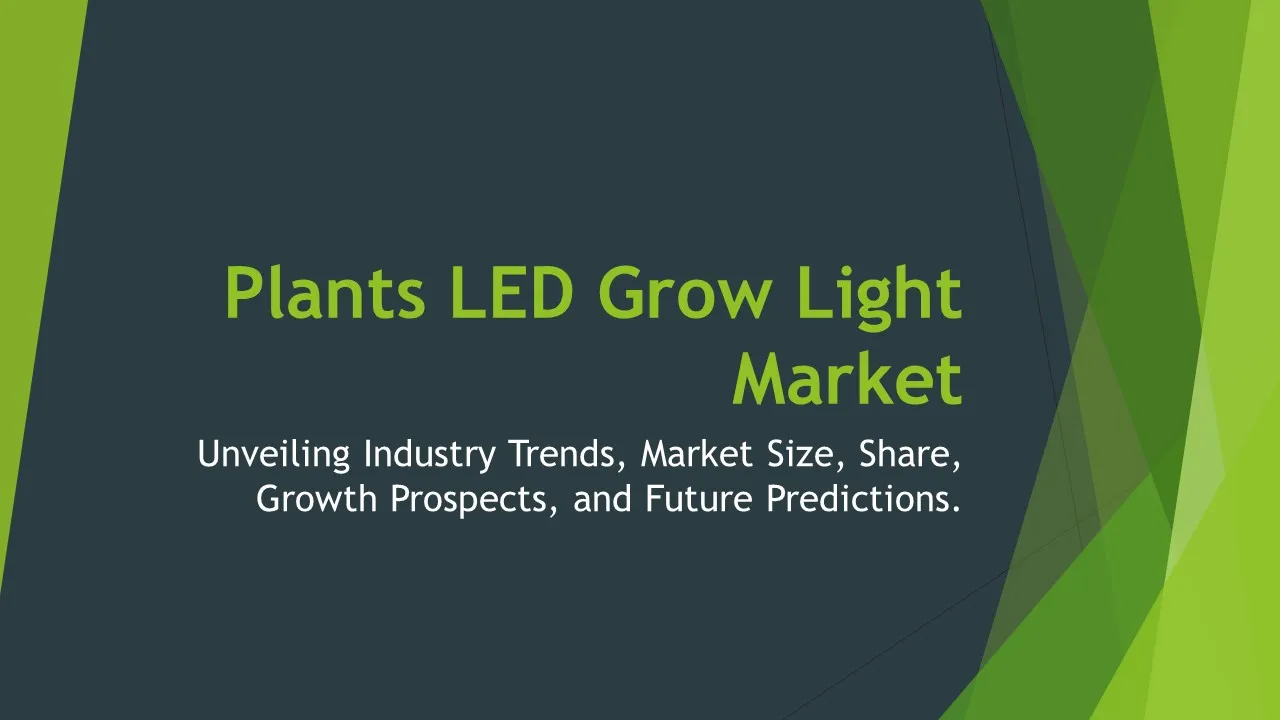Indoor Plant Lighting Sales
Indoor Plant Lighting Market Segments - by Product Type (LED Grow Lights, Fluorescent Grow Lights, HID Grow Lights, Incandescent Grow Lights, Other Grow Lights), Application (Commercial Greenhouses, Vertical Farming, Indoor Gardens, Research Institutions, Other Applications), Distribution Channel (Online Retailers, Specialty Stores, Home Improvement Centers, Garden Centers, Other Channels), Light Spectrum (Full Spectrum, Red Spectrum, Blue Spectrum, White Spectrum, Other Spectrums), and Region (North America, Europe, Asia Pacific, Latin America, Middle East & Africa) - Global Industry Analysis, Growth, Share, Size, Trends, and Forecast 2025-2035
- Report Preview
- Table Of Content
- Segments
- Methodology
Indoor Plant Lighting Sales Market Outlook
The global Indoor Plant Lighting market is anticipated to reach approximately USD 8.3 billion by 2035, exhibiting a remarkable compound annual growth rate (CAGR) of around 12.5% during the forecast period of 2025 to 2035. This robust growth can be attributed to the rising trend of urban gardening, an increase in indoor gardening practices, and the growing awareness of the benefits of artificial lighting for plant growth. As more consumers seek to cultivate plants indoors due to limited outdoor space, the demand for efficient and effective indoor plant lighting solutions continues to escalate. Furthermore, advancements in lighting technology, particularly in LED lighting solutions, are facilitating better energy efficiency and longevity, which are crucial factors driving market growth.
Growth Factor of the Market
A significant growth factor propelling the Indoor Plant Lighting market is the increasing consumer inclination toward sustainable and healthy living, which has led to a rise in indoor gardening practices. The urban population's shift towards green lifestyles is fostering the need for efficient plant lighting solutions that can replicate natural sunlight, promoting plant growth indoors. Furthermore, the rise of vertical farming as a viable agricultural practice is another key contributor, as it requires specialized lighting to optimize growth conditions. The advent of smart lighting technologies, which allow users to control light intensity and spectrum through mobile applications, is also enhancing the attractiveness of indoor plant lighting solutions. Additionally, the need for year-round food production in urban areas is driving innovations and investments in advanced indoor lighting systems, leading to more efficient growth cycles and better crop yields.
Key Highlights of the Market
- Growing popularity of urban gardening and indoor spaces driving demand for plant lighting.
- Technological advancements in LED technologies enhancing energy efficiency.
- Rise of vertical farming and commercial greenhouses boosting market growth.
- Increased consumer interest in sustainable living and organic produce.
- Emergence of smart lighting solutions offering enhanced control and customization.
By Product Type
LED Grow Lights:
LED Grow Lights represent the most rapidly growing segment of the Indoor Plant Lighting market due to their energy efficiency, long lifespan, and low heat output. These lights are capable of emitting specific wavelengths of light that are essential for photosynthesis, making them particularly effective for indoor gardening applications. As technology continues to advance, LED Grow Lights are becoming more affordable and widely adopted by both hobbyists and commercial growers alike. Their ability to be customized for various stages of plant growth enhances their appeal, further driving their market penetration. Many consumers appreciate the reduced electricity costs associated with LED lighting, further incentivizing their adoption for indoor plant cultivation.
Fluorescent Grow Lights:
Fluorescent Grow Lights have been a staple in indoor gardening for many years, especially for beginners and small-scale growers. They are relatively inexpensive compared to other lighting options and are available in various sizes and configurations. These lights provide a good spectrum for seedlings and vegetative plants, making them suitable for indoor gardening applications. However, they emit more heat than LED systems, which can be a limiting factor in tightly controlled indoor environments. Despite this disadvantage, the user-friendly nature and cost-effectiveness of fluorescent grow lights keep them relevant in the market.
HID Grow Lights:
High-Intensity Discharge (HID) Grow Lights are known for their high output and efficiency, particularly in commercial growing situations. They produce a significant amount of light and are often used in larger scale operations like commercial greenhouses and vertical farms. HID lights come in two primary types, Metal Halide (MH) and High-Pressure Sodium (HPS), each emitting different spectrums beneficial for various growth stages. Although these lights are less energy-efficient compared to LED systems, their robust output makes them a preferred choice for serious horticulturists aiming to maximize yields. The market for HID grow lights is stable, but it has seen a gradual decline as LED technology continues to advance.
Incandescent Grow Lights:
Incandescent Grow Lights are the traditional lighting option for indoor gardening, although they are becoming less favored due to their low energy efficiency and high heat output. They produce a warm light that many plants appreciate during early growth stages, but they are not suitable for extended use due to their short lifespan and high energy consumption. While some hobbyists may still use these lights for specific purposes, the growing awareness of better alternatives such as LED and fluorescent lights is leading to a decline in their market share.
Other Grow Lights:
This category includes various unconventional lighting options, such as plasma lights and newer technologies such as quantum dot lighting. While these options are not yet mainstream, they hold potential for niche markets as growers experiment with different light spectrums and efficiencies. Innovations in this space may also pave the way for future developments, as the industry continues to seek out methods to enhance plant growth indoors effectively. However, their current market presence remains limited compared to more established lighting technologies.
By Application
Commercial Greenhouses:
Commercial greenhouses are one of the primary applications for indoor plant lighting, as they rely on controlled environments to enhance crop yields and extend growing seasons. The demand for year-round production in these settings necessitates effective lighting solutions that can mimic sunlight, ensuring optimal photosynthesis and growth rates. Growers are increasingly turning to advanced LED systems that provide customizable light spectrums tailored to specific plant requirements, thus maximizing productivity. Furthermore, the financial viability of commercial greenhouses is significantly enhanced through efficient lighting systems that reduce energy costs while improving crop quality.
Vertical Farming:
Vertical farming is gaining traction globally, especially in urban areas where space is limited. This innovative agricultural approach utilizes stacked layers of crops, requiring specialized indoor lighting to ensure each layer receives adequate light for growth. As vertical farms often operate in controlled environments, sophisticated LED lighting systems are preferred for their energy efficiency and ability to deliver targeted light spectrums for various plant types. The increasing urbanization and demand for fresh produce are driving the growth of vertical farming, creating substantial opportunities for indoor plant lighting solutions tailored to this unique application.
Indoor Gardens:
Indoor gardens have become a popular trend among urban dwellers seeking to enhance their living spaces with greenery. These gardens can range from small herb pots to larger decorative setups, necessitating effective lighting solutions to support plant health and growth. Homeowners are increasingly opting for LED grow lights due to their compact design and energy efficiency, allowing them to cultivate plants indoors without significant energy costs. This segment is expected to continue growing as more people embrace indoor gardening as a hobby and a means to promote healthier lifestyles.
Research Institutions:
Research institutions utilize indoor plant lighting for various studies related to botany, agriculture, and environmental sciences. These organizations often require precise control over lighting conditions to mimic various environmental factors for their experiments. Advanced lighting solutions such as programmable LED systems are essential in these settings, allowing researchers to study the effects of varying light spectrums and intensities on plant growth and development. The demand for such specialized lighting is likely to remain steady as research into agricultural practices continues to evolve.
Other Applications:
Other applications of indoor plant lighting include setups for plant nurseries, educational institutions, and hobbyist growers. These varied applications contribute to the overall demand for effective lighting solutions that cater to diverse plant growth needs. As awareness of the benefits of indoor gardening expands, additional niches are emerging, creating opportunities for manufacturers to develop products that meet the requirements of these less traditional applications. This diversified market approach will enable suppliers to tap into a broader customer base and nurture the growth of innovative lighting technologies.
By Distribution Channel
Online Retailers:
Online retailers have significantly transformed the distribution landscape for indoor plant lighting products. The convenience and accessibility of e-commerce platforms allow consumers to explore a wider variety of products compared to traditional retail stores. This segment has seen substantial growth as more people seek to buy indoor gardening supplies from the comfort of their homes. Additionally, online platforms often provide comprehensive product reviews and customer feedback, enabling consumers to make informed purchasing decisions. The increasing trend toward digital shopping is expected to bolster the online retail segment's market share further.
Specialty Stores:
Specialty stores dedicated to gardening supplies play a critical role in the distribution of indoor plant lighting products. These stores cater to serious gardeners and horticulturists, offering tailored advice and product recommendations based on specific needs. Customers often prefer shopping at specialty stores for the expertise and curated selections available, which can be more comprehensive than those found in general retail outlets. Despite the growth of online shopping, specialty stores continue to thrive by fostering customer relationships and providing personalized service, making them valuable players in the indoor plant lighting market.
Home Improvement Centers:
Home improvement centers are essential distribution channels for indoor plant lighting solutions, as they target homeowners and DIY enthusiasts. These centers typically carry a variety of gardening and lighting products, making it easy for customers to find everything they need for their indoor gardening projects in one place. The integration of indoor gardening supplies within home improvement centers supports the growing trend of home-based gardening, as customers are increasingly looking to enhance their living environments. These centers often employ knowledgeable staff who can guide customers in selecting the right lighting solutions for their specific gardening needs.
Garden Centers:
Garden centers serve as vital distribution points for indoor plant lighting, particularly in regions where gardening is a significant part of the culture. These centers offer a range of products tailored to plant growth, including specialized lighting systems. Customers often rely on garden centers for their expertise and high-quality products, which can enhance their gardening experience. The continued popularity of gardening as a hobby ensures that garden centers remain a key player in the indoor plant lighting market, providing essential resources and products to support plant health and growth.
Other Channels:
This category encompasses various other distribution channels, including wholesalers, agricultural supply stores, and home shows. These channels contribute to the overall distribution of indoor plant lighting solutions by targeting niche markets and specialized customer segments. For instance, wholesalers play a vital role in supplying stores with products, while agricultural supply stores can provide specialized lighting solutions for larger scale operations. Home shows serve as platforms for manufacturers and retailers to showcase their latest products and innovations, allowing consumers to explore options directly. This diversified distribution landscape ensures that indoor plant lighting products are accessible to a wide range of customers.
By Light Spectrum
Full Spectrum:
Full spectrum lighting is designed to provide a complete range of wavelengths, closely mimicking natural sunlight. This type of lighting is ideal for promoting all stages of plant growth, from seedling to flowering. Full spectrum lights are highly favored by both commercial growers and hobbyists due to their versatility and effectiveness in enhancing plant health. As consumers become more informed about the benefits of full spectrum lighting, their demand is expected to grow, driving further innovation in this category. Moreover, advancements in LED technology have made full spectrum lighting more accessible and affordable, contributing to its rising popularity.
Red Spectrum:
The red spectrum is crucial for the flowering and fruiting stages of plant growth. These wavelengths are known to promote flowering and enhance yields, making red spectrum lights a preferred choice for growers focusing on these particular growth phases. While they can be used independently, red spectrum lights are often combined with blue spectrum lights to provide a balanced light environment. As the demand for high-quality produce continues to rise, the red spectrum segment is expected to maintain a strong position within the indoor plant lighting market.
Blue Spectrum:
Blue spectrum lights play a vital role in the vegetative stage of plant growth, fostering leaf development and overall plant health. These lights are particularly popular among growers who focus on leafy greens and herbs, as they promote robust growth and strong stems. Blue spectrum lighting is often employed in conjunction with red spectrum lights to provide a complete range of wavelengths for plants. As consumers increasingly prioritize nutrient-rich crops, the demand for blue spectrum lighting is expected to grow in line with the overall expansion of the indoor gardening market.
White Spectrum:
White spectrum lights are versatile lighting solutions that cater to a wide range of plant types and growth stages. They provide a balanced light source that closely resembles daylight, making them attractive to indoor gardeners who prefer a natural appearance. These lights can be used effectively in both vegetative and flowering stages, allowing for significant flexibility in indoor garden setups. The growing trend of aesthetic indoor gardening, where the visual appeal of plants is prioritized, is likely to support the demand for white spectrum lights in residential settings.
Other Spectrums:
This category includes various other specialized light spectrums, such as ultraviolet (UV) and far-red lights, which have unique applications in indoor gardening. UV lighting can enhance certain aspects of plant growth, while far-red lights can stimulate flowering and elongation. Although these spectrum types are not yet mainstream, they hold potential for niche markets and specialized applications. As research into plant lighting continues to evolve, these alternative spectrums may become more widely adopted, further diversifying the indoor plant lighting landscape.
By Region
The North American region is poised to be a significant market for indoor plant lighting, propelled by the growing trend of urban gardening and increasing interest in sustainability. The region's advanced technological landscape further supports the adoption of innovative lighting solutions, particularly LED systems, which align with the rising preference for energy-efficient options. With an estimated market size of approximately USD 2.5 billion by 2035, North America is expected to exhibit a CAGR of around 11% during the 2025-2035 period. Factors such as the rapid urbanization and changing lifestyles of consumers are expected to drive the demand for indoor plant lighting throughout the region.
Europe is also gaining traction in the indoor plant lighting market, with a strong focus on sustainable agriculture and urban gardening initiatives. The market in this region is projected to reach USD 2.3 billion by 2035, driven by advancements in horticultural technology and the rising popularity of vertical farming. Furthermore, government initiatives aimed at promoting sustainable practices in agriculture are amplifying the demand for efficient indoor lighting solutions. The awareness of indoor gardening benefits among consumers is also growing, leading to a projected CAGR of approximately 10.5% throughout the forecast period.
Opportunities
The indoor plant lighting market presents numerous opportunities, particularly in the realm of technological advancements. With the growth of the smart home trend, there is a rising demand for smart indoor lighting solutions that allow users to remotely control and customize their lighting setups. Integrating IoT (Internet of Things) technology with indoor plant lighting can enable users to monitor their plants' conditions and adjust lighting accordingly, offering a tailored growing experience. This shift towards smart lighting technologies not only enhances plant growth but also simplifies the gardening process for users, catering to both beginners and experienced horticulturists. Manufacturers who invest in smart lighting solutions are likely to gain a significant competitive edge in the market as these innovations attract a wider range of consumers.
Another notable opportunity lies in the expansion of the indoor plant lighting market in emerging economies. As urbanization continues to rise in regions like Asia Pacific and Latin America, the need for efficient indoor gardening solutions is becoming increasingly important. Consumers in these regions are exploring indoor gardening as a means to supplement their food sources and enhance their living environments. This burgeoning interest presents a lucrative market for manufacturers to capture, particularly by offering affordable and energy-efficient lighting solutions tailored to local consumer preferences. As the global population continues to grow, the demand for sustainable food sources will drive further opportunities in the indoor plant lighting sector.
Threats
One of the primary threats to the indoor plant lighting market is the potential saturation of the LED market. As more manufacturers enter the space, competition becomes increasingly fierce, leading to price wars that may ultimately drive down profit margins. With many companies focused on producing similar products, differentiation through innovation becomes imperative. Failure to adapt and innovate in response to changing consumer preferences could lead to significant losses for companies that cannot maintain their competitive edge. This saturation poses a challenge that requires firms to continuously invest in research and development to stay relevant and meet evolving market needs.
Additionally, regulatory challenges regarding energy consumption and environmental impact may pose risks to manufacturers operating within the indoor plant lighting market. Governments worldwide are continuously updating regulations to promote energy efficiency and sustainability, which may affect traditional lighting technologies. Companies must stay ahead of these regulations and adapt their products accordingly to avoid penalties and maintain compliance. As consumers increasingly prioritize eco-friendly products, manufacturers that fail to align their offerings with these regulatory changes may find themselves at a disadvantage in the market.
Competitor Outlook
- Philips Lighting
- Osram Licht AG
- General Electric
- California LightWorks
- Illumitex
- Gavita International B.V.
- Sunblaster Lighting
- Hydrofarm
- Advanced Nutrients
- Black Dog LED
- Kind LED Grow Lights
- Spectrum King LED
- Roleadro
- VIVOSUN
- Mars Hydro
The competitive landscape of the indoor plant lighting market is characterized by the presence of both established and emerging players striving to capture market share and meet the growing demand for innovative lighting solutions. Leading companies such as Philips Lighting and Osram Licht AG are at the forefront, leveraging their extensive experience and technological expertise to develop high-quality products that cater to diverse consumer needs. These industry leaders focus on research and development to enhance energy efficiency and effectiveness, continuously improving their offerings to maintain their competitive positions. Additionally, they employ strategic partnerships and collaborations with agricultural research institutions to create solutions that address the specific needs of commercial growers.
Emerging companies are also making their mark on the indoor plant lighting landscape by introducing innovative products that challenge traditional lighting solutions. Brands like California LightWorks and Gavita International B.V. are recognized for their cutting-edge LED technologies that maximize photosynthesis while minimizing energy consumption. These companies often target niche markets, such as indoor gardeners and vertical farms, offering tailored solutions that differentiate them from larger competitors. The ongoing trend of urban gardening and increased interest in sustainable agriculture create fertile ground for these emerging players to thrive.
The trend towards sustainability is influencing competitive dynamics in the indoor plant lighting market, with companies increasingly focused on developing eco-friendly products. Manufacturers are investing in energy-efficient technologies that align with consumer preferences for sustainable solutions. Advanced Nutrients, for example, not only provides lighting solutions but also combines them with nutrient solutions tailored for indoor gardening, increasing the value proposition for their customers. This holistic approach attracts environmentally conscious consumers, further driving growth in this sector.
1 Appendix
- 1.1 List of Tables
- 1.2 List of Figures
2 Introduction
- 2.1 Market Definition
- 2.2 Scope of the Report
- 2.3 Study Assumptions
- 2.4 Base Currency & Forecast Periods
3 Market Dynamics
- 3.1 Market Growth Factors
- 3.2 Economic & Global Events
- 3.3 Innovation Trends
- 3.4 Supply Chain Analysis
4 Consumer Behavior
- 4.1 Market Trends
- 4.2 Pricing Analysis
- 4.3 Buyer Insights
5 Key Player Profiles
- 5.1 VIVOSUN
- 5.1.1 Business Overview
- 5.1.2 Products & Services
- 5.1.3 Financials
- 5.1.4 Recent Developments
- 5.1.5 SWOT Analysis
- 5.2 Roleadro
- 5.2.1 Business Overview
- 5.2.2 Products & Services
- 5.2.3 Financials
- 5.2.4 Recent Developments
- 5.2.5 SWOT Analysis
- 5.3 Hydrofarm
- 5.3.1 Business Overview
- 5.3.2 Products & Services
- 5.3.3 Financials
- 5.3.4 Recent Developments
- 5.3.5 SWOT Analysis
- 5.4 Illumitex
- 5.4.1 Business Overview
- 5.4.2 Products & Services
- 5.4.3 Financials
- 5.4.4 Recent Developments
- 5.4.5 SWOT Analysis
- 5.5 Mars Hydro
- 5.5.1 Business Overview
- 5.5.2 Products & Services
- 5.5.3 Financials
- 5.5.4 Recent Developments
- 5.5.5 SWOT Analysis
- 5.6 Black Dog LED
- 5.6.1 Business Overview
- 5.6.2 Products & Services
- 5.6.3 Financials
- 5.6.4 Recent Developments
- 5.6.5 SWOT Analysis
- 5.7 Osram Licht AG
- 5.7.1 Business Overview
- 5.7.2 Products & Services
- 5.7.3 Financials
- 5.7.4 Recent Developments
- 5.7.5 SWOT Analysis
- 5.8 General Electric
- 5.8.1 Business Overview
- 5.8.2 Products & Services
- 5.8.3 Financials
- 5.8.4 Recent Developments
- 5.8.5 SWOT Analysis
- 5.9 Philips Lighting
- 5.9.1 Business Overview
- 5.9.2 Products & Services
- 5.9.3 Financials
- 5.9.4 Recent Developments
- 5.9.5 SWOT Analysis
- 5.10 Spectrum King LED
- 5.10.1 Business Overview
- 5.10.2 Products & Services
- 5.10.3 Financials
- 5.10.4 Recent Developments
- 5.10.5 SWOT Analysis
- 5.11 Advanced Nutrients
- 5.11.1 Business Overview
- 5.11.2 Products & Services
- 5.11.3 Financials
- 5.11.4 Recent Developments
- 5.11.5 SWOT Analysis
- 5.12 Sunblaster Lighting
- 5.12.1 Business Overview
- 5.12.2 Products & Services
- 5.12.3 Financials
- 5.12.4 Recent Developments
- 5.12.5 SWOT Analysis
- 5.13 Kind LED Grow Lights
- 5.13.1 Business Overview
- 5.13.2 Products & Services
- 5.13.3 Financials
- 5.13.4 Recent Developments
- 5.13.5 SWOT Analysis
- 5.14 California LightWorks
- 5.14.1 Business Overview
- 5.14.2 Products & Services
- 5.14.3 Financials
- 5.14.4 Recent Developments
- 5.14.5 SWOT Analysis
- 5.15 Gavita International B.V.
- 5.15.1 Business Overview
- 5.15.2 Products & Services
- 5.15.3 Financials
- 5.15.4 Recent Developments
- 5.15.5 SWOT Analysis
- 5.1 VIVOSUN
6 Market Segmentation
- 6.1 Indoor Plant Lighting Sales Market, By Application
- 6.1.1 Commercial Greenhouses
- 6.1.2 Vertical Farming
- 6.1.3 Indoor Gardens
- 6.1.4 Research Institutions
- 6.1.5 Other Applications
- 6.2 Indoor Plant Lighting Sales Market, By Light Spectrum
- 6.2.1 Full Spectrum
- 6.2.2 Red Spectrum
- 6.2.3 Blue Spectrum
- 6.2.4 White Spectrum
- 6.2.5 Other Spectrums
- 6.3 Indoor Plant Lighting Sales Market, By Distribution Channel
- 6.3.1 Online Retailers
- 6.3.2 Specialty Stores
- 6.3.3 Home Improvement Centers
- 6.3.4 Garden Centers
- 6.3.5 Other Channels
- 6.1 Indoor Plant Lighting Sales Market, By Application
7 Competitive Analysis
- 7.1 Key Player Comparison
- 7.2 Market Share Analysis
- 7.3 Investment Trends
- 7.4 SWOT Analysis
8 Research Methodology
- 8.1 Analysis Design
- 8.2 Research Phases
- 8.3 Study Timeline
9 Future Market Outlook
- 9.1 Growth Forecast
- 9.2 Market Evolution
10 Geographical Overview
- 10.1 Europe - Market Analysis
- 10.1.1 By Country
- 10.1.1.1 UK
- 10.1.1.2 France
- 10.1.1.3 Germany
- 10.1.1.4 Spain
- 10.1.1.5 Italy
- 10.1.1 By Country
- 10.2 Asia Pacific - Market Analysis
- 10.2.1 By Country
- 10.2.1.1 India
- 10.2.1.2 China
- 10.2.1.3 Japan
- 10.2.1.4 South Korea
- 10.2.1 By Country
- 10.3 Latin America - Market Analysis
- 10.3.1 By Country
- 10.3.1.1 Brazil
- 10.3.1.2 Argentina
- 10.3.1.3 Mexico
- 10.3.1 By Country
- 10.4 North America - Market Analysis
- 10.4.1 By Country
- 10.4.1.1 USA
- 10.4.1.2 Canada
- 10.4.1 By Country
- 10.5 Middle East & Africa - Market Analysis
- 10.5.1 By Country
- 10.5.1.1 Middle East
- 10.5.1.2 Africa
- 10.5.1 By Country
- 10.6 Indoor Plant Lighting Sales Market by Region
- 10.1 Europe - Market Analysis
11 Global Economic Factors
- 11.1 Inflation Impact
- 11.2 Trade Policies
12 Technology & Innovation
- 12.1 Emerging Technologies
- 12.2 AI & Digital Trends
- 12.3 Patent Research
13 Investment & Market Growth
- 13.1 Funding Trends
- 13.2 Future Market Projections
14 Market Overview & Key Insights
- 14.1 Executive Summary
- 14.2 Key Trends
- 14.3 Market Challenges
- 14.4 Regulatory Landscape
Segments Analyzed in the Report
The global Indoor Plant Lighting Sales market is categorized based on
By Application
- Commercial Greenhouses
- Vertical Farming
- Indoor Gardens
- Research Institutions
- Other Applications
By Distribution Channel
- Online Retailers
- Specialty Stores
- Home Improvement Centers
- Garden Centers
- Other Channels
By Light Spectrum
- Full Spectrum
- Red Spectrum
- Blue Spectrum
- White Spectrum
- Other Spectrums
By Region
- North America
- Europe
- Asia Pacific
- Latin America
- Middle East & Africa
Key Players
- Philips Lighting
- Osram Licht AG
- General Electric
- California LightWorks
- Illumitex
- Gavita International B.V.
- Sunblaster Lighting
- Hydrofarm
- Advanced Nutrients
- Black Dog LED
- Kind LED Grow Lights
- Spectrum King LED
- Roleadro
- VIVOSUN
- Mars Hydro
- Publish Date : Jan 21 ,2025
- Report ID : EL-31626
- No. Of Pages : 100
- Format : |
- Ratings : 4.5 (110 Reviews)









